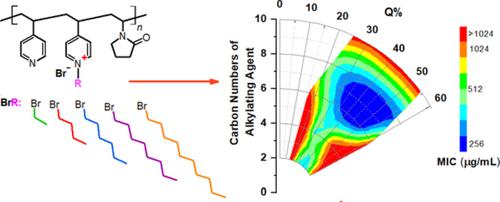当前位置:
X-MOL 学术
›
Polym. Int.
›
论文详情
Our official English website, www.x-mol.net, welcomes your feedback! (Note: you will need to create a separate account there.)
Antibacterial properties of cationic copolymers as a function of pendant alkyl chain length and degree of quaternization
Polymer International ( IF 3.2 ) Pub Date : 2020-12-20 , DOI: 10.1002/pi.6170 Damla Gokkaya 1, 2 , Murat Topuzogullari 2 , Tulin Arasoglu 3 , Kubra Trabzonlu 3 , Mehmet Murat Ozmen 2 , Suzan Abdurrahmanoğlu 1
Polymer International ( IF 3.2 ) Pub Date : 2020-12-20 , DOI: 10.1002/pi.6170 Damla Gokkaya 1, 2 , Murat Topuzogullari 2 , Tulin Arasoglu 3 , Kubra Trabzonlu 3 , Mehmet Murat Ozmen 2 , Suzan Abdurrahmanoğlu 1
Affiliation

|
Antibacterial polymers are promising materials in the fight against bacterial infection which is a vital health problem. Among these materials, cationic (co)polymers with quaternary ammonium groups are of great interest and importance as they interact with the bacterial membrane causing cell death. The antibacterial efficacy can be improved by modifying the pendant alkyl groups and charge density of the polycation. In this study, alkylbromides with different chain lengths were used to obtain quaternized poly(4‐vinylpyridine‐co‐N‐vinylpyrrolidone) (P(4VP‐co‐NVP)) copolymers of various positive charge densities and pendent alkyl chain lengths. While the chemical structures of the produced copolymers were characterized by Fourier transform infrared and 1H NMR spectroscopy, physicochemical properties such as size and zeta potential were measured by dynamic light scattering spectrometry. It was determined that the zeta potentials and hydrodynamic diameters of the samples vary between +10 and +32 mV and 10 and 16 nm, respectively. The antibacterial activity of the copolymers were tested against Escherichia coli and Staphylococcus aureus bacteria by broth microdilution and standard ‘plate’ count methods. The results revealed that the antibacterial activity of the copolymers against Escherichia coli can be successfully adjusted through varying the chain length of the alkylating agent (hydrophobic chains) and the degree of quaternization (positive charge density). © 2020 Society of Chemical Industry
中文翻译:

阳离子共聚物的抗菌性能随烷基侧链长度和季铵化程度的变化而变化
抗菌聚合物是抗击细菌感染的有前途的材料,细菌感染是至关重要的健康问题。在这些材料中,具有季铵基团的阳离子(共)聚合物与细菌膜相互作用会导致细胞死亡,因此受到极大的关注和重视。可以通过修饰烷基侧基和聚阳离子的电荷密度来提高抗菌效果。在这项研究中,用不同链长alkylbromides用于获得季铵化的聚(4- vinylpyridine-共- ñ乙烯基吡咯烷酮)(P(4VP-共-NVP))各个正电荷密度和侧链烷基链长的共聚物。生成的共聚物的化学结构通过傅立叶变换红外光谱和1 H NMR光谱法通过动态光散射光谱法测量诸如大小和ζ电势的物理化学性质。确定样品的ζ电势和流体动力学直径分别在+10和+ 32mV以及10和16nm之间变化。通过肉汤微量稀释和标准的“平板”计数法测试了共聚物对大肠杆菌和金黄色葡萄球菌的抗菌活性。结果表明,可以通过改变烷基化剂的链长(疏水链)和季铵化程度(正电荷密度)来成功调节共聚物对大肠杆菌的抗菌活性。©2020化学工业协会
更新日期:2020-12-20
中文翻译:

阳离子共聚物的抗菌性能随烷基侧链长度和季铵化程度的变化而变化
抗菌聚合物是抗击细菌感染的有前途的材料,细菌感染是至关重要的健康问题。在这些材料中,具有季铵基团的阳离子(共)聚合物与细菌膜相互作用会导致细胞死亡,因此受到极大的关注和重视。可以通过修饰烷基侧基和聚阳离子的电荷密度来提高抗菌效果。在这项研究中,用不同链长alkylbromides用于获得季铵化的聚(4- vinylpyridine-共- ñ乙烯基吡咯烷酮)(P(4VP-共-NVP))各个正电荷密度和侧链烷基链长的共聚物。生成的共聚物的化学结构通过傅立叶变换红外光谱和1 H NMR光谱法通过动态光散射光谱法测量诸如大小和ζ电势的物理化学性质。确定样品的ζ电势和流体动力学直径分别在+10和+ 32mV以及10和16nm之间变化。通过肉汤微量稀释和标准的“平板”计数法测试了共聚物对大肠杆菌和金黄色葡萄球菌的抗菌活性。结果表明,可以通过改变烷基化剂的链长(疏水链)和季铵化程度(正电荷密度)来成功调节共聚物对大肠杆菌的抗菌活性。©2020化学工业协会



























 京公网安备 11010802027423号
京公网安备 11010802027423号